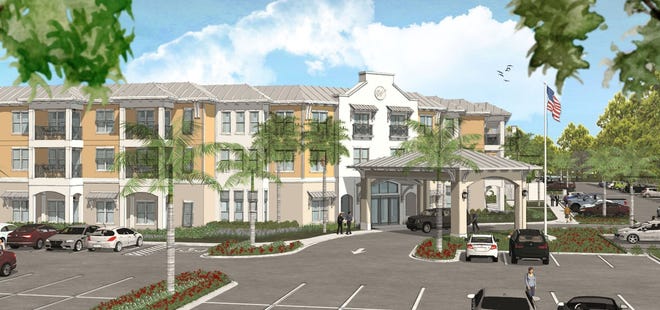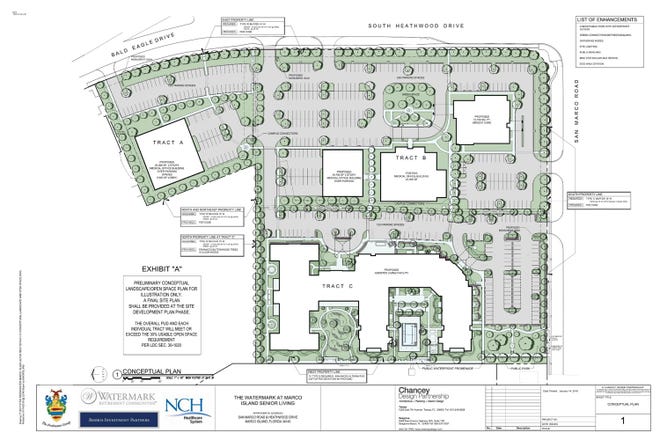Developer makes case for assisted living facility ahead of Marco City Council meeting
 Devan Patel
Devan Patel
If the recent discussions of the Watermark at Marco Island’s assisted living facility didn’t convey the enormity of the project, the City Council has cleared the vast majority of its agenda Tuesday to give the matter ample time for consideration and debate.
For months, the project, proposed for the southwest corner of San Marco Road and Heathwood Drive, has been at the forefront of the discussion about the need and appropriateness for such a facility to be placed on Marco Island and the impact it would have on nearby residents.
Although the project received a recommendation for approval from the Planning Board after developers agreed to reduce the size of the facility to three stories and limiting the number of beds to 210, detractors still remain.
Walt Chancey, an architect and a member of the development group pushing the project, said some of those concerns are based upon misinformation and when the City Council considers the actual facts, he believed the project should merit its ultimate approval.
More:Council supports changes LDC code change that would aid assisted living facility buildout
More:Marco Island assisted living facility discussion pushed to Jan. 22
More:Planning board approves PUD application for Marco Island assisted living facility
NCH, which owns the nearly 12-acre parcel, is looking to sell five acres and with the proceeds from the transaction, it would construct a new 12,000-square-foot urgent care facility on one of the remaining tracts. The bigger picture vision for the parcel is to rezone it into a planned unit development to facilitate a medical campus.

Throughout the rezoning process, concerns have been raised about an abundance of issues ranging from the need to safety to traffic impacts and increasing density. Along with those concerns have been statements about the facility that aren’t born through truth, Chancey said.
One of the most frequently voiced concerns about the project is the perceived increase in density on Marco Island. Marco Island’s comprehensive plan, which tries to maintain the small-town atmosphere, allows for 12 units per acre for PUDs.
Mathematically speaking, the 166 units proposed would exceed the allowable 143 units by 23 units according to the letter of the law. However, Chancey said that in itself is misleading because the impacts and intensity of an assisted living facility are not the same as a normal housing unit.
Part of the issue has been reaching an agreement that some form of an equivalency ratio needs to be applied. Marco Island's land development code does not have an equivalency ratio.
“It’s in almost every city and county in Florida,” Chancey said.
Even by applying the smallest equivalency ratio in Florida of 2.39 ALF beds to one dwelling unit, the plan would be consistent with the city’s comprehensive plan. Lee and Collier County’s own equivalency ratios for assisted living facilities are four ALF beds to one dwelling unit for most PUDs.
The Watermark at Marco Island is essentially asking for a ratio of 1.16 to be applied.
The largest myth being perpetuated about the Watermark at Marco Island is that it represents a mega-ALF facility, a statement Chancey said couldn’t be further from the truth.
Besides the proposed Marco Island project being one the smallest facilities the Watermark Retirement Communities has built in Florida, the project would have fewer assisted living beds than any of the other communities in either Naples or Fort Myers.
By comparison, two facilities in Naples have fewer total beds but only offer assisted living options. The Watermark would consist of 80 assisted living beds, 32 memory care beds and 71 independent living units.
Together, these totals would equate to an average size continuum of care facility, not the mega-sized facility as opined. VI and Bently Village in Naples and Shell Point in Fort Myers have 1,114 and 1,978 bed respectively.
Along with misconceptions about the size of the facility, Chancey refuted the notion that the Marco Island facility would be drawing in most of its clientele from other areas.
Citing market research, Chancey said the vast majority of people that move into an assisted living facility search for a place within 5-10 miles of their home in order to maintain that connection with their families and friends.
The Watermark recently updated its market demand survey, which shows that there are an abundance of locals that could benefit from the facility and not have to move away.
“Five miles from our site, the demand needed today is 273 assisted, 89 memory care and 382 independent living units,” Chancey said. “I don’t understand the argument that people are coming from Naples when there are plenty of facilities closer to them.”

For traffic, Chancey conceded that there would be increased activity from the facility, but then again how it could it not be when there is an empty lot where the proposed facility would sit.
The facility is anticipated to staff 37 people during the daytime before tapering off to 26 in the evening and 11 during the night. Although the facility would house some independent living units, the number of car trips from those residents are projected to be minimal, Chancey said.
Chancey cited Marco Island Public Works Director Tim Pinter and Community Affairs Director Dan Smith in noting that the facility’s construction would not offer any changes to the traffic level of service.
“There’s nothing that we would need to do to change the level of service for the entire PUD built out 100 percent,” Chancey said. “That’s rare that some PUD doesn’t have some effect. We have no impact on the level of service for traffic.”
The last major argument against the facility has centered around evacuations and hurricane preparedness.
Some opponents of the project have questioned the safety of placing an assisted facility on a barrier island, but that would not be a unique concept in Florida.
"The idea that seniors don't belong on a barrier island is just like saying school kids or a handicapped person shouldn't be there because they can't get themselves off like you or I," Chancey said.
As part of its mandated license requirements, the facility is required to have an approved emergency management plan that also includes having transportation services on retainer even if it does not use them.
Watermark's contract would call-in those services 72 hours before hurricane landfall and evacuation would be completed within 8-12 hours.
The state also requires facilities to have a receiving contract in the event of evacuation and with six other facilities in the state, residents would be evacuated to them.
As for the building itself, it will be built to the highest standards so that when it's time to return home, it will be there waiting for them, Chancey said.
"You can stay in this place and be safe for most hurricanes, but you don’t do that,” Chancey said. “You evacuate. The point is that the building is going to be safe.”
More:Planning board delays decision on proposed assisted living facilities on Marco Island
More:Commentary: Proposed assisted living facility inconsistent with Marco culture